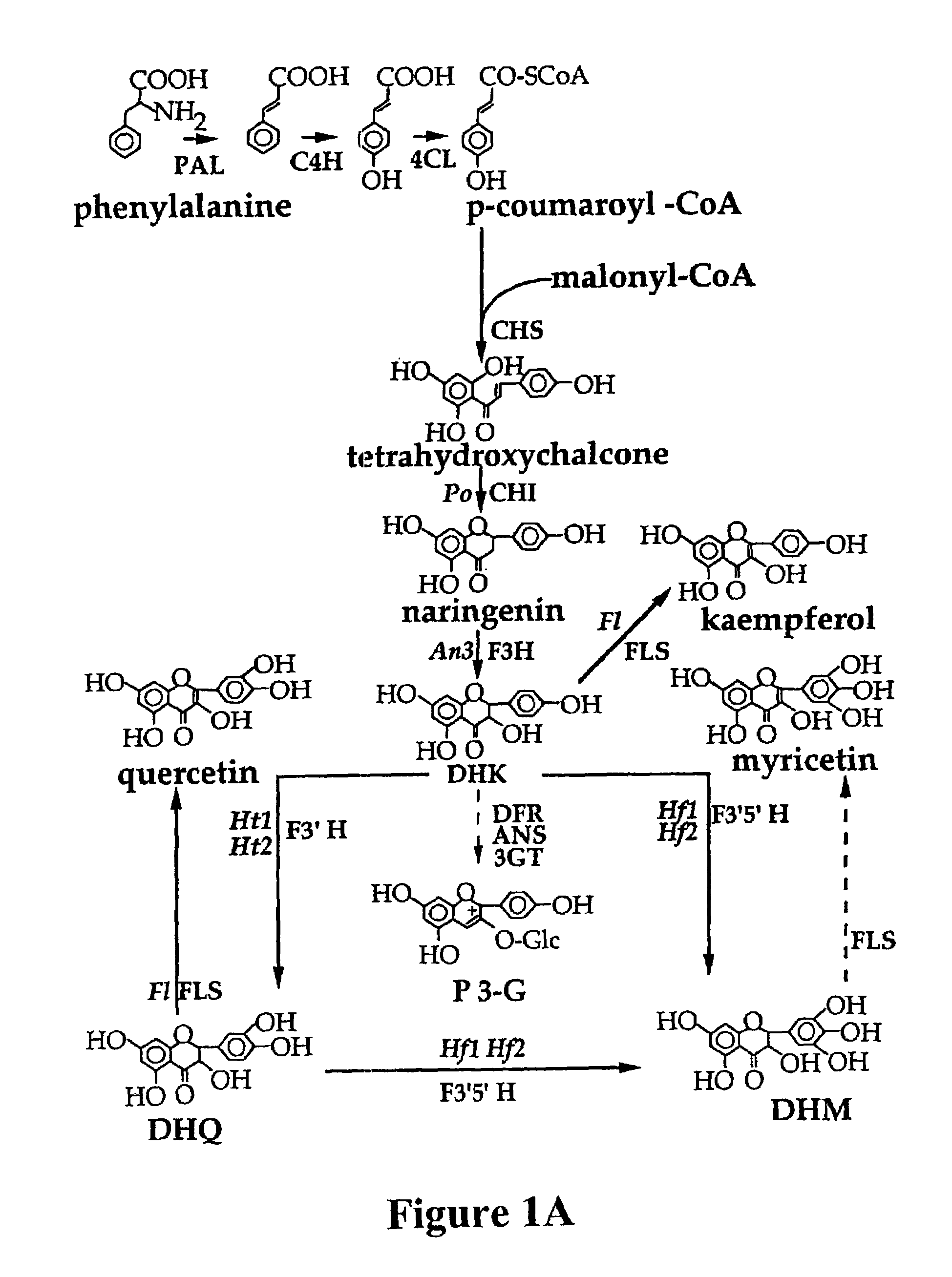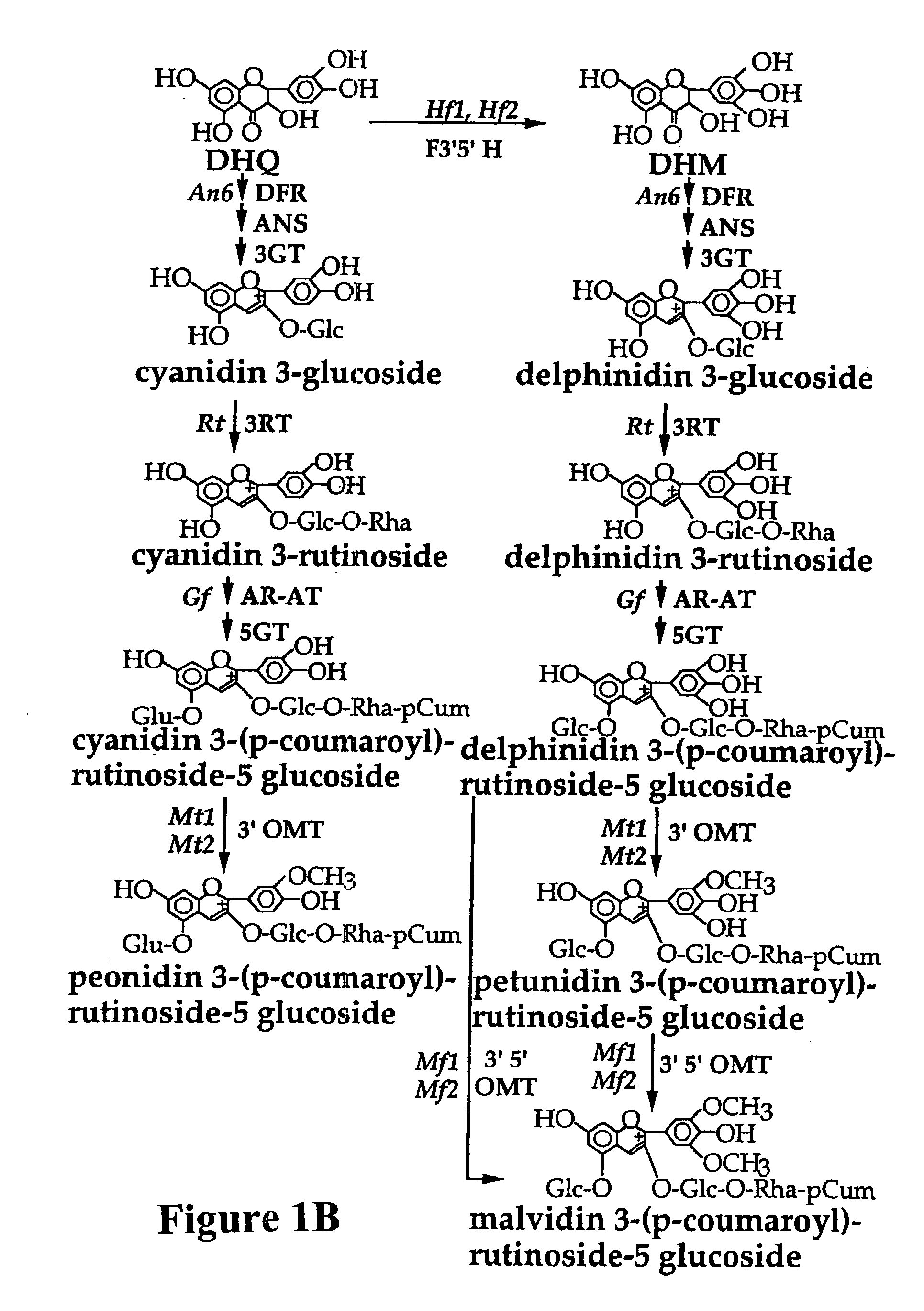Plant anthocyanidin rutinoside aromatic acyl transferases
a technology of aromatic acyl transferase and plant anthocyanidin, which is applied in the field of gene encoding a polypeptide having aromatic acyl group transfer activity, can solve the problems of limited application and achieve the effect of improving the affinity of the acyl group
- Summary
- Abstract
- Description
- Claims
- Application Information
AI Technical Summary
Benefits of technology
Problems solved by technology
Method used
Image
Examples
example 1
Plant Material
[0127]The Petunia hybrida cultivars used are presented in Table 2.
[0128]
TABLE 2Petunia hybrida cultivarsPlantSource / varietyPropertiesReferenceV23An1, An2, An3, An4, An6, An8, An9, An10,Wallroth et al.ph1, Hf1, Hf2, ht1, Rt, po, Bl, Fl(1986)Doodeman etal. (1984)R51An1, An2, An3, an4, An6, An8, An9, An10,Wallroth et al.An11, Ph1, hf1, hf2, Ht1, rt, Po, bl, fl(1986)Doodeman etal. (1984)VRV23 × R51 F1 HybridBr140An1, An2, an4, an6 / An6*, Ph1, Ph2, Ph5,INRAHf1, Ht1, Rt, po, Mt1, mf1, mf2, Gf, flOldF1 Hybrid (commercial cultivar)Ball Seed,GloryUSABlue(OGB)V26An1, An2, An3, an4, An6, An8, An9, An10,INRAAn11, Ph1, ph2, Ph5, Hf1, hf2, Ht1, Rt, po,Bl, Gf, Mt1, Mt2, mf1, mf2, FlW162an1VrijeUniversiteit,AmsterdamINRA = Institut National de la Recherche Agronomique, Cedex, France
OGB petunia plants were grown in specialized growth rooms with a 14 hr day length at a light intensity of 10,000 lux and a temperature of 22 to 26° C. OGB flowers were harvested at developmental stages defin...
example 2
Bacterial Strains
[0132]The Escherichia coli strains used were:
[0133]
DH5αsupE44, Δ(lacZYA-ArgF)U169, (ø80lacZΔM15), hsdR17(rk−,mk+), recA1, endA1, gyrA96, thi-1, relA1, deoR. (Hanahan,1983 and BRL, 1986).XL1-supE44, hsdR17(rk−, mk+), recA1, endA1, gyrA96, thi-1, relA1,Bluelac−,[F′proAB, lacIq, lacZΔM15, Tn10(tetR)] (Bullock et al.,1987).PLK-F′recA, hsdR17(rk−, mk+), mcrA−, mcrB−′lac−, supE44, galK2,galT22, metB1, [F′ proAB, lacIq, lacZΔM15, Tn10(tetR)](Stratagene).
example 3
General Methods
[0134]In general, the methods followed were as described in Sambrook et al. (1989).
[0135]The disarmed Agrobacterium tumefaciens strain used was AGL0 (Lazo et al., 1991).
[0136]The cloning vectors pBluescript, pBluescribe and PCR script were obtained from STRATAGENE. pCR7 2.1 was obtained from INVITROGEN.
E. coli Transformation
[0137]Transformation of the E. coli strains was performed according to the method of Inoue et al., (1990).
[0138]DNA fragments (50 to 100 ng) were radioactively labelled with 50 μCi of [α-32P]-dCTP using a Gigaprime kit (GENEWORKS). Unincorporated [α-32P]-dCTP was removed by chromatography on a Sephadex G-50 (Fine) column.
Plasmid Isolation
[0139]Helper phage R408 (STRATAGENE) was used to excise pBluescript phagemids containing petunia cDNA inserts from the amplified λZAP cDNA libraries using methods described by the manufacturer. E. coli XL1-Blue were transfected with the phagemid mixture and the colonies were plated out on...
PUM
| Property | Measurement | Unit |
|---|---|---|
| Fraction | aaaaa | aaaaa |
| Magnetic field | aaaaa | aaaaa |
| Aromaticity | aaaaa | aaaaa |
Abstract
Description
Claims
Application Information
 Login to View More
Login to View More - R&D
- Intellectual Property
- Life Sciences
- Materials
- Tech Scout
- Unparalleled Data Quality
- Higher Quality Content
- 60% Fewer Hallucinations
Browse by: Latest US Patents, China's latest patents, Technical Efficacy Thesaurus, Application Domain, Technology Topic, Popular Technical Reports.
© 2025 PatSnap. All rights reserved.Legal|Privacy policy|Modern Slavery Act Transparency Statement|Sitemap|About US| Contact US: help@patsnap.com



